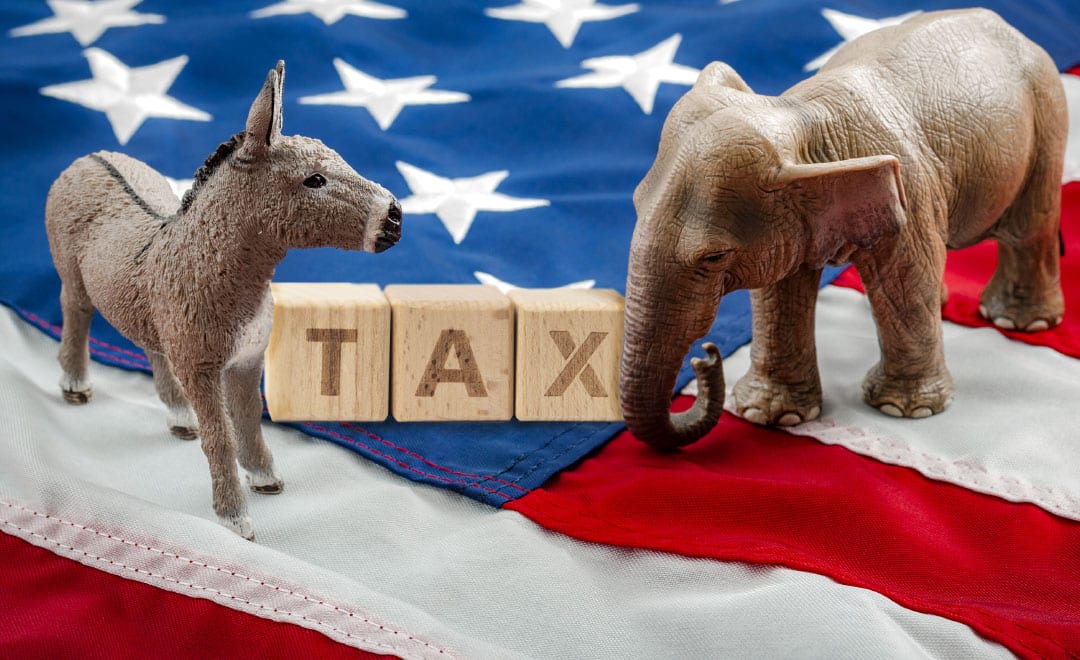As the November 2020 elections approach, you might want to know what the two front-running presidential candidates’ tax plans for the future are. The following is an overview of their positions, at least what is known now. However, the political and economic landscapes can change, and there is no assurance these plans won’t be revised or that they will have eventual Congressional backing. However, the information may be helpful as you look toward future tax planning.
| ISSUE | CURRENT LAW | TRUMP | BIDEN |
|---|---|---|---|
| Individual Tax Rates | Range from 10% to 37%. The top rate is scheduled to return to 39.6% in 2026. | Generally, would continue with current rates by extending the Tax Cuts and Jobs Act past 2025. However, would lower the rate for middle class taxpayers, possibly by bringing the 22% rate down to 15%. | Would return the top rate to the pre-tax reform 39.6% immediately (if approved by Congress). |
| Capital Gains Tax Rates | Range from 0% to 20%; Collectibles top rate is 28%. | Would continue with current rates by extending the Tax Cuts and Jobs Act beyond 2025. | Increase top rate to 39.6% for taxpayers with over $1millon of income. |
| Basis Step Up on Inherited Property | A beneficiary uses as their basis of an inherited asset the fair market value at the date of death. (Basis is the amount from which future gain or loss is determined.) | No proposed change. | Would eliminate the step up, either by taxing “paper gains” at death or assigning the decedent’s basis to the beneficiary (details are not clear at this time). |
| Qualified Opportunity Zones | Permits deferral of capital gains invested in qualified opportunity zone funds. | Would continue current program as is. | Would add additional qualifying restrictions and reporting requirements. |
| Sec 199A Pass-Through Deduction | Provides individuals with a deduction equal to 20% of income from their businesses other than C-corporations and certain service businesses. Most rental activities are eligible for the deduction. | Would continue current program as is. | Would phase the deduction out for higher income taxpayers. Would remove rental income as qualified income for the deduction. |
| Pease Limitation | Suspended through 2025. When in effect, itemized deductions are limited for higher-income taxpayers. | Would continue the suspension by extending the Tax Cuts and Jobs Act. | Would reinstate the Pease Limitation for those with income over $400,000. |
| Itemized Deductions | No overall limitation currently | No such proposal | Would limit the tax benefit of the deductions to 28% of income. |
| SALT Tax Limitation | Limits the itemized deduction for state and local taxes to $10,000. | Continue current limitation. | Would eliminate the SALT limitation. |
| Renter’s Credit | No current law. | No such proposal. | Would establish a low-income renter’s credit that would be designed to limit the cost of rent and utilities to 30% of income. |
| First Time Homebuyer’s Credit | The last time there was a home- buyer’s credit was in 2008 and it was in the form of a 15-year loan with certain forgiveness provisions. | No such proposal. | Would reinstate the credit in the amount of $15,000 (which is double the 2008 credit amount) and make it permanent. |
| Social Security Taxes | Earned incomes are subject to a tax rate of 12.4% on the first $137,700 (2020). For employees, half is paid by the employer. | No proposed change. | Would have the tax resume when earned income exceeds $400,000. |
| Earned Income Tax Credit | Provides a tax credit for lower-income workers based upon the amount of their income from working. No credit allowed for individuals without a qualifying child who are age 65 and above. | No proposed change. | Would make credit available to older workers. |
| Child and Dependent Care Tax Credit | A non-refundable credit of 20% to 35% (based on income) of the expenses to care for a child or disabled dependent so the taxpayer can work. Expenses limited to $3,000 for one and $6,000 for two or more. | No proposed change. | Would make the credit refundable and increase the expense limit to $8,000 for one child or disabled dependent and $16,000 for two or more. Also, would increase the top credit percentage to 50%. |
| Corporate Tax Rate | 21% | Would continue the 21% by extending the Tax Cuts and Jobs Act. | Would increase it to 28%. |
| Premium Tax Credit for Health Care | Affordable Care Act provides individuals whose household income is up to 400% of the federal poverty level premium assistance in the form of a tax credit when purchasing health insurance through a government marketplace. | Would like ACA repealed. | Would remove the 400% cap on income and use the gold, rather than silver level, plan in the computation. |
These are just proposals of what changes might happen based on the election results. It takes acts of Congress to move plans into law. With various scenarios in play, it might be wise to look at proactive tax planning to minimize future tax liability. If you have questions on your year-end tax planning, the experts at Henssler Financial will be glad to help:
- Experts Request Form
- Email: experts@henssler.com
- Phone: 770-429-9166








